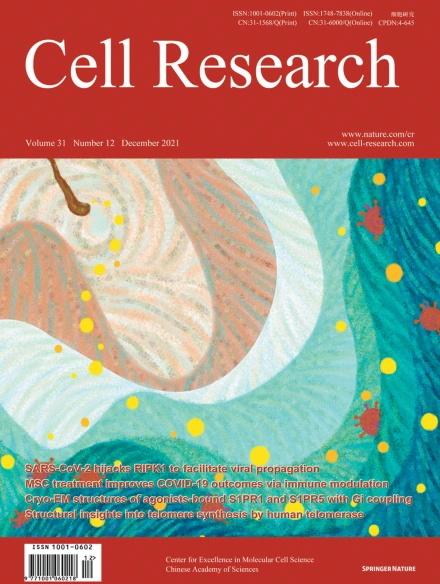
Advanced Search
Submit Manuscript
Advanced Search
Submit Manuscript
Volume 31, No 12, Dec 2021
ISSN: 1001-0602
EISSN: 1748-7838 2018
impact factor 17.848*
(Clarivate Analytics, 2019)
Volume 31 Issue 12, December 2021: 1311-1314 |
Cryo-EM structure of constitutively active human Frizzled 7 in complex with heterotrimeric Gs
Lu Xu1,2,3,4,† , Bo Chen1,† , Hannes Schihada5,† , Shane C. Wright5,6,† , Ainoleena Turku5,8 , Yiran Wu1 , Gye-Won Han7 , Maria Kowalski-Jahn5 , Pawel Kozielewicz5 , Carl-Fredrik Bowin5 , Xianjun Zhang1,2,3,4,7 , Chao Li1,2,3,4 , Michel Bouvier6 , Gunnar Schulte5,* , Fei Xu1,2,3,4,*
1iHuman Institute, ShanghaiTech University, Shanghai, ChinaDear Editor,
The ten mammalian Frizzleds (FZD1–10) belong to the class F of G protein-coupled receptors (GPCRs) and mediate WNT signaling through interaction with transducer proteins including Dishevelled (DVL) or heterotrimeric G proteins.1 Their involvement in human disease has put FZDs at the forefront of drug targets, especially anti-cancer therapy.2 However, no drugs have been developed for efficient pharmacological modulation of FZDs, partially owing to the limited understanding of FZD structure and activation mechanisms.1,3 Among class F, FZD7 is intensively pursued due to its relevance in various tumor models, particularly in intestinal cancers.4 Detailed structures of the receptor complexes would allow for structure-guided discovery of new drug candidates. FZD1–10 share structural similarity with the related class F member Smoothened (SMO), which mediates Hedgehog signaling and is a validated target for cancer therapy.2 In an effort to understand the structural basis of FZD activation and transducer interaction, we solved the structure of human FZD7 in complex with heterotrimeric mini Gs (mGs).5
https://doi.org/10.1038/s41422-021-00525-6